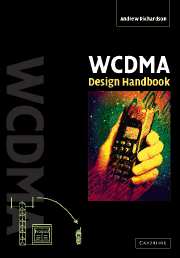Book contents
- Frontmatter
- Dedication
- Contents
- Preface
- Acknowledgements
- List of abbreviations
- 1 Introduction
- 2 WCDMA in a nutshell
- 3 Spreading codes and modulation
- 4 Physical layer
- 5 RF aspects
- 6 Chip rate processing functions
- 7 Symbol rate processing functions
- 8 Layer 2 - medium access control (MAC)
- 9 Layer 2 - RLC
- 10 PDCP and BMC protocols
- 11 Layer 3 - RRC
- 12 Measurements
- 13 NAS
- 14 Idle mode functions
- Appendix
- References
- Index
2 - WCDMA in a nutshell
Published online by Cambridge University Press: 05 October 2013
- Frontmatter
- Dedication
- Contents
- Preface
- Acknowledgements
- List of abbreviations
- 1 Introduction
- 2 WCDMA in a nutshell
- 3 Spreading codes and modulation
- 4 Physical layer
- 5 RF aspects
- 6 Chip rate processing functions
- 7 Symbol rate processing functions
- 8 Layer 2 - medium access control (MAC)
- 9 Layer 2 - RLC
- 10 PDCP and BMC protocols
- 11 Layer 3 - RRC
- 12 Measurements
- 13 NAS
- 14 Idle mode functions
- Appendix
- References
- Index
Summary
In this chapter, we address some of the fundamental concepts behind the design and operation of the WCDMA system. Many of the issues addressed here will be considered in greater detail in later chapters.
We start by reviewing the basic protocol architecture and principles behind its operation. Next, we consider aspects of the design and operation of the physical layer such as the concepts behind the physical channels, the ideas behind soft-handover, and consideration of other physical layer techniques such as power control. Following this, we address the operation of the radio interface from a higher layer perspective by considering the modes and states that are defined for the WCDMA system, and subsequently the methods used to identify and address the UE. We then consider some of the operational aspects of the radio interface, including the definitions of radio links, RBs, radio access bearers and signalling radio bearers (SRBs). Next, we consider the principles of the security architecture. This extends over a range of layers and so it is worth considering it in one section in detail. We conclude with a summary of the operation that a UE will follow in the establishment of some typical services. This section provides some context in which we can consider the remainder of the book.
- Type
- Chapter
- Information
- WCDMA Design Handbook , pp. 24 - 63Publisher: Cambridge University PressPrint publication year: 2005



